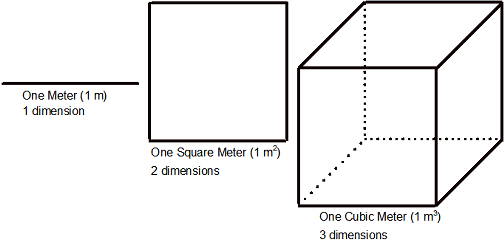
The SI units of area and volume are the square meter (m2) and the cubic meter (m3). They are called derived units because they are built up from simpler units. In the image below the differences between length, area and volume units are made clear. To measure a length requires just one dimension, one measurement. To measure area requires two dimensions: two lengths multiplied together. To measure volume requires three dimensions: three lengths multiplied together.

To convert from one unit of area or volume to another can be done in two ways. First, the length conversion factor can be used to make a new conversion factor for area or volume. Second, the length conversion factor can be used more than once: twice for area units and three times for volume units.
Here is how to do this, step-by-step:
1 ft = 12 in 1 mi = 5,280 ft
(1 ft)2 = (12 in)2 (1 mi)2 = (5,280 ft)2
1 ft2 = 144 in2 1 mi2 = 2.78784 × 107 ft2
Now that you have a conversion factor, use it:
144 in2
2 ft2 × --------- = 288 in2
1 ft2
1 m = 100 cm 3 ft = 1 yd
(1 m)3 = (100 cm)3 (3 ft)3 = (1 yd)3
1 m3 = 1 × 106 cm3 27 ft3 = 1 yd3
Now that you have a conversion factor, use it:
1 × 106 cm3
3.5 m3 × ----------- = 3.5 × 106 cm3
1 m3
Here is how to do this, step-by-step:
Convert cm2 to m2:
1 m 1 m
45,000 cm2 × ———————— × ———————— = 4.5 m2
100 cm 100 cm
Convert m3 to ft3
3.28 ft 3.28 ft 3.28 ft
5.2 m3 × ——————— × ——————— × ——————— = 183 ft3
1 m 1 m 1 m
Do your work on a separate piece of paper, being sure to label each problem clearly. To do these problems you may need your conversions chart from the original dimensional analysis packet and your metric units chart.
Create conversion factors between the two units given in each problem.
Perform the following conversions, showing all work.